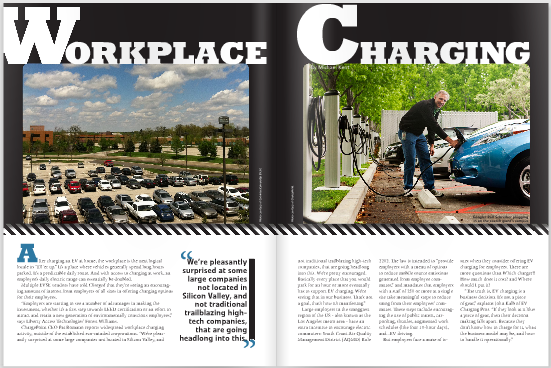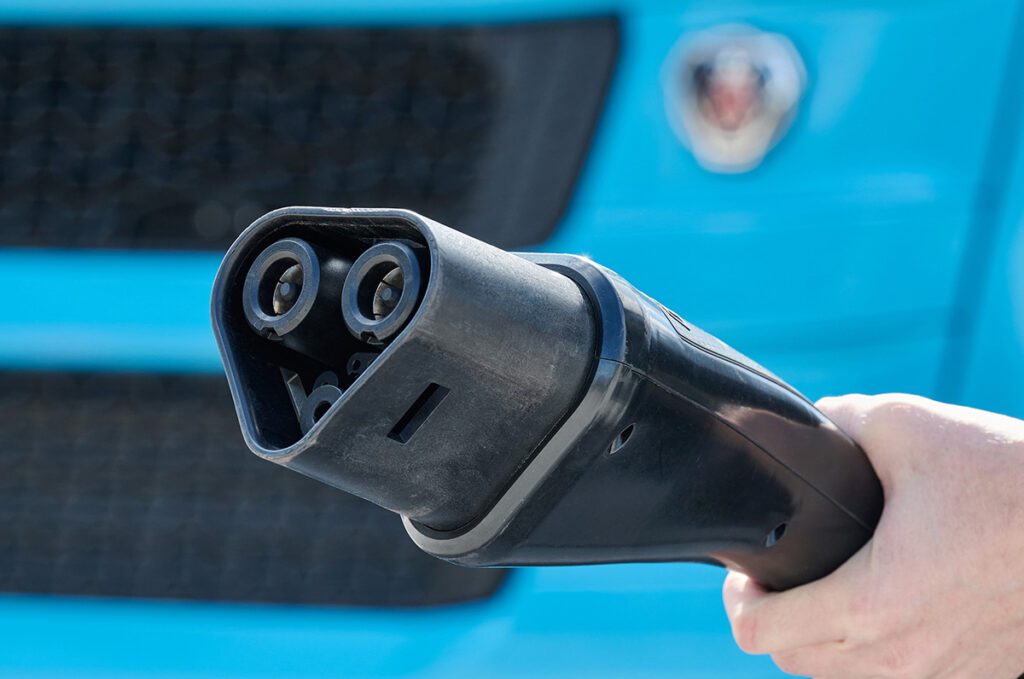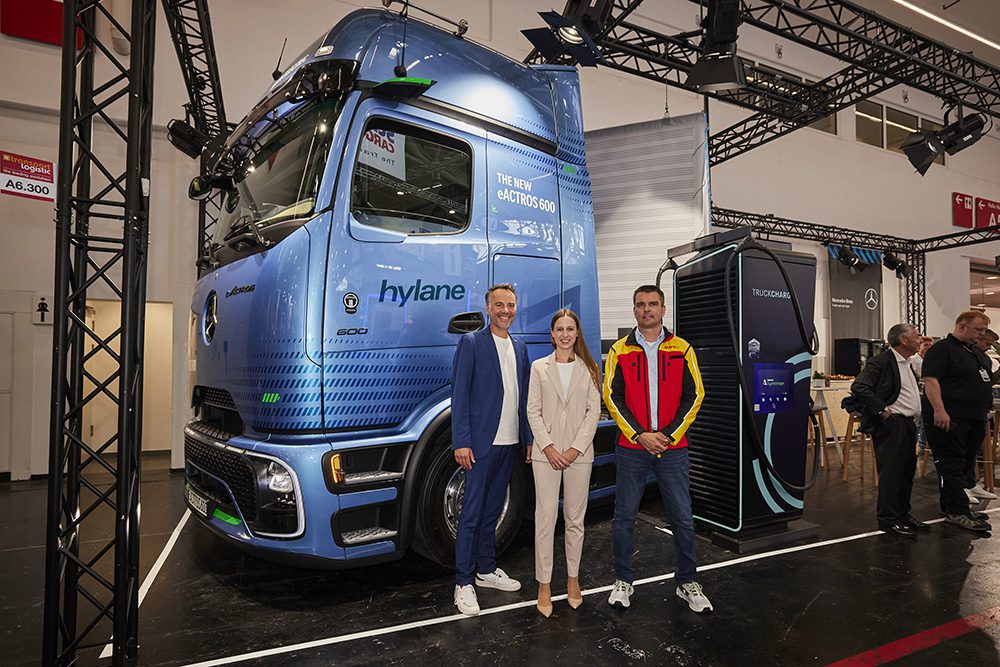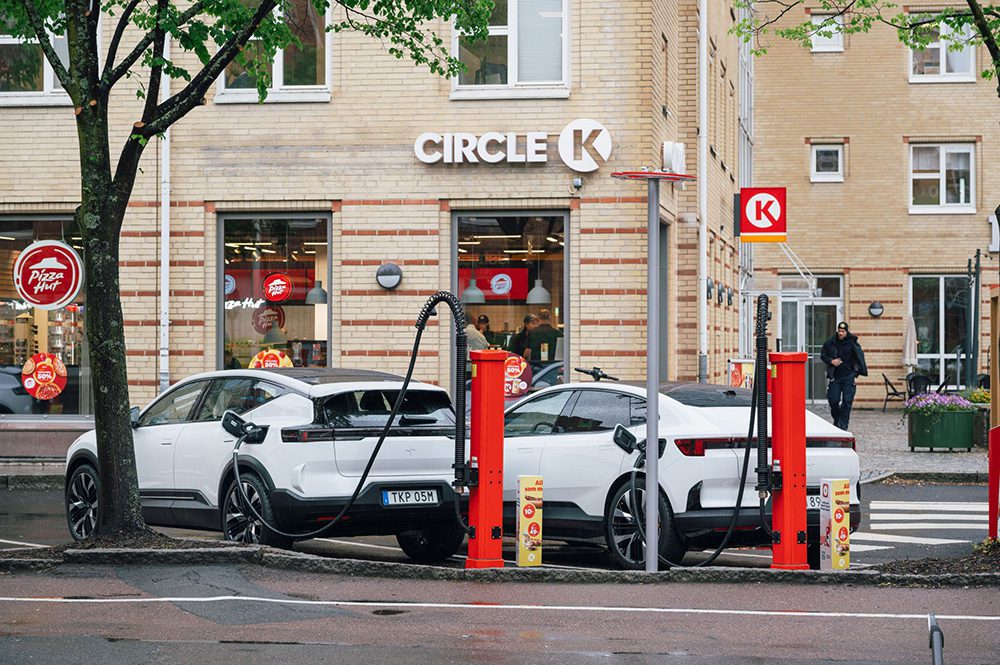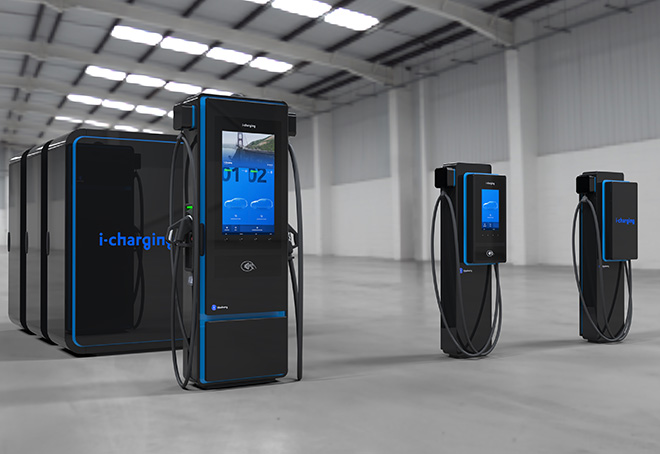The charging experts talk workplace EVSE: free vs fee, Level 1 or 2, ROI, networking and more.
After charging an EV at home, the workplace is the next logical locale to “fill ‘er up.” It’s a place where vehicles generally spend long hours parked. It’s a predictable daily route. And with access to charging at work, an employee’s daily electric range can essentially be doubled.
Multiple EVSE vendors have told Charged that they’re seeing an encouraging amount of interest from employers of all sizes in offering charging options for their employees.
“Employers are starting to see a number of advantages in making the investment, whether it’s a first step towards LEED certification or an effort to attract and retain a new generation of environmentally conscious employees,” says Liberty Access Technologies’ Forest Williams.
 ChargePoint CEO Pat Romano reports widespread workplace charging activity, outside of the established eco-minded corporations. “We’re pleasantly surprised at some large companies not located in Silicon Valley, and not traditional trailblazing high-tech companies, that are going headlong into this. We’re pretty encouraged. Basically every place that you would park for an hour or more eventually has to support EV charging. We’re seeing that in our business. That’s not a goal, that’s how it’s manifesting.”
ChargePoint CEO Pat Romano reports widespread workplace charging activity, outside of the established eco-minded corporations. “We’re pleasantly surprised at some large companies not located in Silicon Valley, and not traditional trailblazing high-tech companies, that are going headlong into this. We’re pretty encouraged. Basically every place that you would park for an hour or more eventually has to support EV charging. We’re seeing that in our business. That’s not a goal, that’s how it’s manifesting.”
Large employers in the smoggiest region of the US – also known as the Los Angeles metro area – have an extra incentive to encourage electric commuters: South Coast Air Quality Management District (AQMD) Rule 2202. The law is intended to “provide employers with a menu of options to reduce mobile source emissions generated from employee commutes,” and mandates that employers with a staff of 250 or more at a single site take meaningful steps to reduce smog from their employees’ commutes. These steps include encouraging the use of public transit, carpooling, shuttles, augmented work schedules (like four 10-hour days), and…EV driving.

But employers face a maze of issues when they consider offering EV charging for employees. There are more questions than Which charger? How much does it cost? and Where should I put it?
“The truth is, EV charging is a business decision. It’s not a piece of gear,” explains John Kalb of EV Charging Pros. “If they look at it like a piece of gear, then their decision making falls apart. Because they don’t know how to charge for it, what the business model may be, and how to handle it operationally.”
Level 1 or 2
The first question employers face is whether to offer Level 1 or Level 2 charging – perhaps the easiest to answer. If the majority of your employees work full time (eight-hour days) and commute around 25 miles or less one-way, then Level 1 charging is probably more than adequate.
If a large portion of your employees work part-time, or often travel in and out of the office (for meetings, deliveries, or service calls for example), then you may want to offer Level 2 charging.

“On the Level 1 side, we’re starting to see a lot of RFPs, and there is probably going to be some funding activity for workplace that is Level 1 focused,” says Daniel Shanahan of EVSE LLC, a subsidiary of Control Module, Inc. “It’s simpler. You don’t have to upgrade the panel. It doesn’t work in every case, but we believe that Level 1 is a workable solution for many locations.”
Fee or free
The next question is whether or not to charge employees for using electricity. Here is where it begins to get tricky.
An amenity
So you want to provide electricity for free to employees, and maybe even to visitors, as an amenity or complimentary service? You won’t need a billing system, but you will need a way to track usage. Surely the IRS will eventually catch up to the trend and make EV charging at work a taxable fringe benefit that must be reported. Also, by giving electricity away you run the risk of a gasser uprising over an employee equity issue. “If you let them plug in, then where is my free gas card?”
John Kalb doesn’t find the free versus fee debate to be a big hurdle. “The sticking point is: Are we even going to make it available in the first place? Most are not charging for the electricity. It doesn’t seem to be a big enough number for anyone to really worry about. The only issue comes from other employees.”

ROI
When a company chooses to charge a fee, it will need an EVSE solution with a payment system and access control.
For government agencies considering installing EVSE, a clear path to recouping all costs (installation and electricity) must be in place to avoid entering into “gift of public funds” territory – a heavily regulated minefield that most experts recommend avoiding.
In this case, it’s important to keep installation costs low, so that you don’t have to charge high fees to recover them, which could discourage use.
Networked vs non-networked
Then there is the networking question: Do I want to pay a monthly fee to have a charging network service provider handle the management and administration of the EVSE?
Well, the network providers surely think you should.
“First of all, ChargePoint brings in customers,” says CEO Pat Romano. “Once we put you on our map, people looking for parking will prefer that parking garage over one that doesn’t have EV charging. Non-networked systems aren’t going to do that.” For semi-public parking areas shared by employees and potential customers, networked EVSE could be a big benefit.
There is also the issue of charger availability. ECOtality VP Colin Read explains that “whenever you have a situation that requires access restrictions, you need a networked, smart-charging station. This allows drivers to locate charging stations on a map, find directions, and see if those charging stations are available. Without this, parking garages are running the risk that drivers will assume the charging station will be available, only to arrive and find it in use. Ultimately, it is about enhancing the customer experience to allow for ease of access.”

These are good features, but at what cost? If a parking lot operator or government facility wants to recover costs, are the monthly fees of a fully networked solution cost-prohibitive?
Romano says, no way. In fact, he insists ChargePoint will save you money in the long run. “The network fees are super low relative to if a workplace wanted to roll out their own. Frankly, if you’re any workplace at all you have to have some sort of network for access control and authentication, and a super high-functionality charger and a limited-functionality charger don’t have any cost difference, because it’s all software.”
“If someone wanted to roll their own system, and do all that manual administration, they would spend far more money. And we provide 24/7 customer support, so the receptionist in the workplace is not the support person for EV charging. They call us.”
Spot reserved for…
It’s pretty clear that EV drivers are drawn to lots with charging options that appear on cell phone apps and navigation systems. But in the private parking world, where each space is paid for and reserved for one particular person, lot operators aren’t interested in being found on the map.
In that case, why not install standard 120 V outlets and allow drivers to use their own cord sets? Give them a window sticker and charge a flat monthly fee for the electricity. Sure, that’s the simplest option, if you’re not interested in any usage data or access control.
But what about parking lot operators that would like more control? They don’t necessarily need a full network. They need something local that integrates with their existing systems – a “network lite.”
Well, they’re in luck, because there are also EVSE solution providers that will integrate with the parking industry’s gate and billing systems, like Liberty Access Technologies and Control Module.
“Many charging stations force the operator to use the EVSE’s credit card system, when many parking lots and garages already have a payment processor and billing service in place,” explains Daniel Shanahan of Control Module. “Adding another merchant service account is redundant, and has double fees. Instead of telling a multi-million-dollar parking industry that you’re going to adapt to our charging station, to our networks and payment, we are taking the position that the EVSE needs to become an integrated function of the garage.”

“If I’m the garage owner,” says Liberty’s Forest Williams, “I’m willing to put some chargers up on my tab. But I don’t want to have to pay the expense of a fully networked charger, and I don’t need someone to service the plug. If it breaks, I can send my own electrician out to fix it.”
Both companies will build systems that piggyback on a parking garage’s existing assets. For example, when someone drives into the garage they get a ticket at the gate. They can use that ticket to turn on a charger (via a magnetic swipe or a code system). When they drive out, they pay for parking and charging. If employees use an RFID badge to enter the garage and open doors, that same badge can activate the charger.
Parking lot owners can also use a pay-by-phone (PBP) system, eliminating the need for a payment kiosk. Parking meters around the world are adopting PBP technology, so why not charging stations? (Standard credit card processing fees will apply.)
Catering specifically to the parking industry could prove to be a shrewd long-term strategy. In the US alone, it’s estimated to generate $25-30 billion in gross parking revenues, with more than 100 million commercial parking spaces.
Manufacturer offerings
Charged talked to Eaton, AeroVironment, DBT, and Schneider Electric about their product offerings for workplace-specific applications. They all echoed the same sentiment: Much like every other aspect of the EV charging industry, workplace charging is complicated. There is no one-size-fits-all product solution.
“Workplace is obviously a broad umbrella, there are so many types of environments where people work,” AeroVironment’s Frank Wong told us. “So, the applications for charging vary just as widely.” Which is why we see so many different options from the ESVE makers.
For example, DBT recently announced its new “four in one” portfolio, which provides four stages of charging intelligence. There ia a “dumb charger” for free access and free charging; a controlled-access, no-fee charger; a controlled-access, paid charger; and a build-your-own-network solution. They can also retrofit the “dumb charger” if you want upgrade the features in the future.
Eaton offers chargers with a variety of billing and access control options. You can purchase the Pow-R-Station connected to Eaton’s own billing and maintenance network, a ChargePoint compatible unit, a USA Technologies ePort credit card reader, or Liberty’s Synchronous Codes non-network secure access system. Other EVSE manufacturers are following suit and giving customers similar access control and billing options.
Workplace projects
PARC
When the Palo Alto Research Center (PARC), a Xerox company, began to look into EV charging for their facilities, it started by speaking to a couple of equipment vendors. But that only left PARC with more questions, so it turned to EV Charging Pros. “I worked with them over the past six months to develop the workplace plan,” said John Kalb. “We started by running a survey of all of their employees. Do they have EVs? Are they interested in EVs? If they had EV charging, would that in fact influence future EV purchases? How far are their commutes? Then we surveyed the physical site and power available.”
PARC is now in the process of installing four Level 2 chargers in its visitor parking lot, and 8 Level 1 chargers in the employee lot (with enough capacity to scale to 16 Level 1 chargers in the future). The company has made a big commitment, and is upgrading transformers. “The project is not a three- or five-thousand-dollar project; it’s six figures,” said Kalb. “They’re basically putting in the infrastructure today to serve their needs tomorrow.”
The company is offering charging at no cost to employees, and already has an alternative transportation program that provides benefits for things like taking the bus, or riding motorcycles. So it can easily institute an EV driver part of that program.
Westport Train Station
Just east of New York City is the Westport, Connecticut Train Station, with a parking lot that is home to a couple of hundred cars a day. Commuters pre-pay for the spots and typically leave their vehicles there from eight to 14 hours a day.
When they approached EVSE LLC about offering charging to commuters, they were originally thinking about a Level 2 networked solution. “We suggested that if people are parking that long, they should consider Level 1,” said Daniel Shanahan. “And since they already have the customers in their database, why not mail them RFID cards and charge them a flat fee every year?”
In the end, EVSE LLC designed a dual Level 1 pedestal for them, with RFID access control and a network that tracks who’s charging and when. “Because Level 1 demands less power, all the chargers are powered by new solar panels on the station roof – a totally off-grid solution that makes sense,” says Shanahan.
County of Los Angeles
The County of Los Angeles has over 2,600 government buildings, 101,000 employees, and a fleet of 14,000 vehicles (which uses 14 million gallons of fuel a year). On top of the fleet’s fuel consumption, the average employee commutes 24 miles each way, accounting for 32 percent of the county’s greenhouse gas emissions, second only to that produced by the county buildings.
“We’re currently looking at EVSE as a compliance strategy for Rule AQMD 2202,” said Rick Teebay of the county’s Office of Sustainability.
The county government was one of 23 agencies in the state that recently received a grant from the California Energy Commission to install 315 EVSEs, 48 of which will go up in the County of Los Angeles. As one of the lead agencies, the county solicited bids for a Master Purchasing Agreement. It received submissions from 13 different firms representing 13 different EVSE manufacturers, with wildly differing cost proposals. The hardware alone ranged from $1,250 for a simple wall mount, all the way up to $12,000 for a heavily ruggedized unit that looks like it could withstand an IED blast.
The county won’t need to recover its capital costs, but it will need to recover its operational costs, to avoid a “gift of public funds” situation. It has also asked for proposals for software and back-end systems. “We’re looking for something that’s open, so everyone can use it. Each of the networks has different RFIDs, which we don’t want. We want something that doesn’t require people/employees to join memberships.”
Teebay says they’re currently considering two solutions that offer the “openness” they desire.

Learning their language
John Kalb of EV Charging Pros thinks the charging market is suffering from a bit of a language barrier, with regard to the real estate industry.
“There is a real difference between the real estate industry perspective and the EV industry perspective. We need to learn how to speak the language of real estate.”
When a CFO of a commercial property is thinking about installing EV chargers, it’s going to come out of the capital budget. But the capital budget has many other pressures – a new chiller, energy-efficient lighting, marble in the lobby. “I’ve got $100,000 to spend this year on making my property better, what do I do, what are my priorities? The issue is: how do we get workplaces and commercial property owners to prioritize EV charging?” For the most part, EV chargers fall under that intangible category, with the possibility of charging a fee for use and making some money over time.
To help CFOs see the big picture, Kalb presents a model of capital cost, maintenance cost, and yearly operating cost against potential utilization over a five-year period. “CFOs are looking at the modified internal rate of return. My spreadsheet calculates the return for an EVSE project over a period of time, which allows them to compare apples to apples. That’s one method that they use to prioritize projects.”






